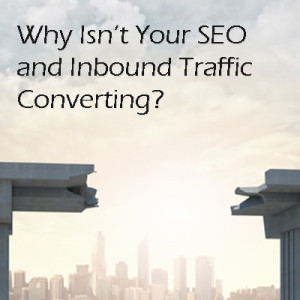
Inbound marketing is the rage these days. And for good reason. Social, search, and content have proven to be very effective in digital marketing awareness.
So you create a few awareness campaigns, and your organic SEO keywords and hits are starting to roll in. You’re getting more traffic to the site, your content is getting more visibility, and you’re ranking for your targeted keywords…you can celebrate now and watch the leads roll in. Right?
Well, if you’re like many businesses you’re probably not getting as many leads and customers as you originally thought. You’re getting traffic, sure, but it’s not converting. Why not?
Hummingbirds and Shrinking Attention Spans
If you’re getting the SEO traffic and it’s just not converting, then it’s not necessarily an SEO problem (as many marketers originally suspect). It’s a website marketing problem. A keyword is a question. When a prospect types a keyphrase into Google it’s because they’re looking for the answer to a question, or the solution to a problem. Are your visitors landing on the right page? Are you positioning yourself, your products or services as what they need to solve their pain point? Striking that right balance between persuasive and smarmy is tricky, but critical to conversion.
At a digital marketing conference I attended a few months ago, speaker Allen Gannett astutely summed up the personality of our searchers: “we’re in a war of attention and our customers are hummingbirds – fluttering around and consuming bits of content everywhere.” Per a Nielsen study, he stated the average U.S. internet user looks at 2,417 different websites every month, and only spends 1 minute and 12 seconds per site on average.(Source: more goodness about this here).
5 Essential Website Elements to Diagnose
So how do we compete in a world of shrinking attention spans? Here are 5 things you need to do to better position yourself and convert more traffic:
- Understand the critical difference between copywriting and content Copywriting is copy that is intended to persuade. If your sales pages, products pages, services pages, etc. are all informing (much like an article), and lack positioning then a reader really has no reason to act. They’ll walk away after reading a nice page but not be moved to act or do anything.
- Your website must have goals, and every page MUST HAVE a call to action (CTA). This is one of the biggest errors I see when doing SEO site audits and reviewing copy. A page has good information on it, but then ends randomly and abruptly. When your prospect, or reader, gets to the end of the page – what do you want them to do? Don’t leave it to chance or feel like the next step is implied. Tell them. Reach out to you? Take a demo? Visit another page? Give them the next step – always. And you should have goals for your website, and those should be reinforced naturally across the design, copy, buttons and graphics.
- Answer the question: Why you? It’s critical that you put yourself in a searcher’s shoes and address this in the copy of your page. When they come to your page through an organic search (using keywords), they have no idea who you are or if you are legit. Today’s buyer has no time to waste. So if you’re answering a question – or addressing a need – you have to go the extra mile and make it a no-brainer to them that YOU are the solution they need. And let’s be clear – you don’t have to be in overtly in their face or smarmy, but I do see so many businesses who are so afraid of seeming “sales-y” they go too far in the other direction. And lastly, for goodness’ sakes – show some personality. You cannot succeed these days with a personality that’s as exciting as cardboard.
- Get people to come back. Most visitors these days are not ready to reach out after their first, or second, or third their visit to your site. This is increasingly common as more buyers take longer to ensure they’ve done their homework and become an educated buyer before they make a purchasing decision. Do you have an email capture box with an enticing offer to sign up for your list? Multiple offers? Converting website traffic full of interested prospects onto your email list is essential so you can nurture them and build that know, like and trust over time. (Hubspot offers some great examples if you need inspiration for your inbound marketing campaigns.)
- Your website design has got to be fresh. When is the last time you’ve had your website design freshened up? Due to our increasingly digitized lifestyles, attention spans are getting increasingly shorter. Shorter as in less than the attention span of a goldfish, according to this Times article. When a searcher lands on your page, you have .025 seconds to convince this person that you run a legit company and that you’re a real person behind the site. Does your website design convey trust and authority? Is it clear or cluttered? Do you showcase your social proof and accolates? Take an honest look at your site, and at your SEO landing pages (this report is found in Google Search Console and/or Google Analytics) and consider if this could be the reason your traffic isn’t converting.
Thanks to the plethora of data we have at hand, diagnosing and course correcting is easier than ever. Check out this article for more specifics on Google Analytics reports and metrics for SEO.
SEO |